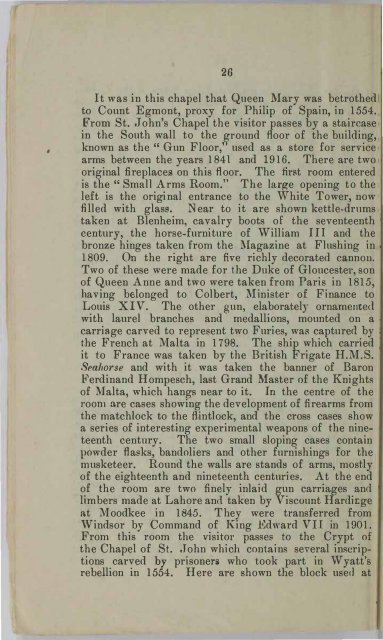Authorised Guide to the Tower of London
Create successful ePaper yourself
Turn your PDF publications into a flip-book with our unique Google optimized e-Paper software.
26<br />
It was in this chapel that Queen Mary was betro<strong>the</strong>d<br />
<strong>to</strong> Count Egmont, proxy for Philip <strong>of</strong> Spain, in 1554.<br />
From St. John's Chapel <strong>the</strong> visi<strong>to</strong>r passes by a staircase<br />
in <strong>the</strong> South wall <strong>to</strong> <strong>the</strong> round floor <strong>of</strong> <strong>the</strong> building,<br />
known as <strong>the</strong> " Gun Floor,' used as a s<strong>to</strong>re for service<br />
arms between <strong>the</strong> years 1841 and 1916. There are two,<br />
original fireplaces on this floor. The first room entered<br />
is <strong>the</strong> " Small Arms Room." The la,rO'e opening <strong>to</strong> <strong>the</strong><br />
left is <strong>the</strong> original entrance <strong>to</strong> <strong>the</strong> White <strong>Tower</strong>, now<br />
filled with glass. Near <strong>to</strong> it are shown kettle-drums<br />
taken at Blenheim, cavalry boots <strong>of</strong> <strong>the</strong> seventeenth<br />
century, <strong>the</strong> horse-furniture <strong>of</strong> William III and <strong>the</strong><br />
bronze hinges taken from <strong>the</strong> Magazine at Flushing in<br />
1809. On <strong>the</strong> right are five richly decorated cannon.<br />
Two <strong>of</strong> <strong>the</strong>se were made for <strong>the</strong> Duke <strong>of</strong> Gloucester, son<br />
<strong>of</strong> Queen Anne and two were taken from Paris in 1815,<br />
having bdonged <strong>to</strong> Colbert, Minister <strong>of</strong> Finance <strong>to</strong><br />
Louis XIV. The o<strong>the</strong>r gun, elaborately ornamented.<br />
with laurel branches and medallions, mounted on a<br />
carriage carved <strong>to</strong> represent two Furies, was captured by<br />
<strong>the</strong> French at Malta in 1798. The ship which carried<br />
it <strong>to</strong> France was taken by <strong>the</strong> British Frigate H.M.S.<br />
Seahorse and with it . was taken <strong>the</strong> banner <strong>of</strong> Baron<br />
Ferdinand Hompesch, last Grand Master <strong>of</strong> <strong>the</strong> Knights<br />
<strong>of</strong> Malta, which hangs near <strong>to</strong> it. In <strong>the</strong> centre <strong>of</strong> <strong>the</strong><br />
room are cases showing <strong>the</strong> development <strong>of</strong> firearms from<br />
<strong>the</strong> matchlock <strong>to</strong> <strong>the</strong> flintlock, and <strong>the</strong> cross cases show<br />
a series <strong>of</strong> interesting experimental weapons <strong>of</strong> <strong>the</strong> nineteenth<br />
century. The two small sloping cases contain<br />
powder flasks, bandoliers and o<strong>the</strong>r furnishings for <strong>the</strong><br />
musketeer. Round <strong>the</strong> walls are stands <strong>of</strong> arms, mostly<br />
<strong>of</strong> <strong>the</strong> eighteenth and nineteenth centuries. At <strong>the</strong> end<br />
<strong>of</strong> <strong>the</strong> room are two finely inlaid gun carriages and<br />
limbers made at Lahore and taken by Viscount Hardicge<br />
at Moodkee in 1845. They were transferred from<br />
Windsor by Command <strong>of</strong> King Bdward VII in 1901.<br />
From this room <strong>the</strong> visi<strong>to</strong>r passes <strong>to</strong> <strong>the</strong> Crypt <strong>of</strong><br />
<strong>the</strong> Chapel <strong>of</strong> St. ,T ohn which contains several inscriptions<br />
carved by prisoners who <strong>to</strong>ok part in Wyatt's<br />
rebellion in 1554. Here are shown <strong>the</strong> block used at



